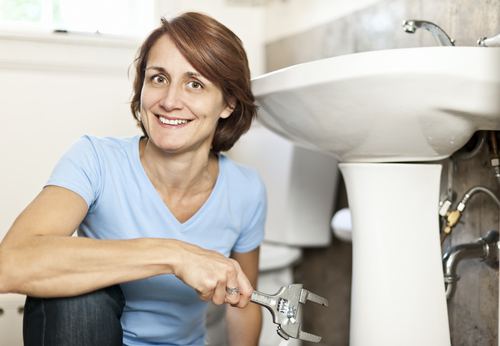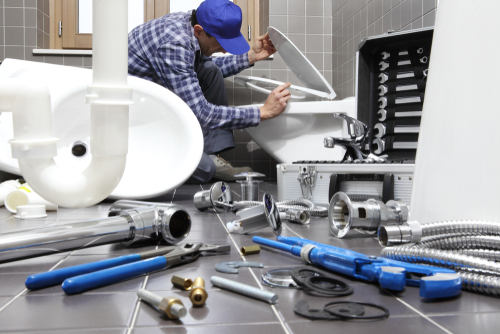The bathroom is an integral part of any home. You want to keep it clean, functioning, and aesthetically pleasing at all times. Homeowners often have problems when it comes to toilet and bathroom maintenance. While a toilet installation and repair service is possible, you can also opt for a Do-It-Yourself or DIY approach.

DIY is a solution that allows you to save money and use your toilet without waiting for someone else to take care of it. Here are toilet installation and repair tips when doing it yourself:
1. Make sure you have all the tools you need
Toilet installation can be a difficult process so before you start a toilet installation, you need to make sure that you have all the necessary tools to accomplish it yourself. Being prepared will save you time, make you more efficient, and will avoid unnecessary frustrations because you can’t proceed for the next step.
Some of the standard tools needed for toilet installation are:
- Tape measure for taking measurements
- Adjustable wrench for loosening or tightening bolts
- Utility knife for scoring the caulk((ha
- Pliers for adjusting nuts and bolts
- Locking pliers to help tighten jaws of the tool so they don’t slip while pulling or rotating
- Slip joint pliers for adjusting nuts and bolts
- 4-in-1 screwdriver for removing bolts under the seat
- Cordless drill to make round holes or driving fasteners
- Caulk gun for applying caulk
- Level to establish a horizontal plane
- Hacksaw for cutting metal or plastic tubes
- Shop vacuum for sucking up water
- Rags for cleaning after
Additionally, changing out a toilet typically requires the following materials:
- Wax ring to seal the toilet to the floor
- Brass toilet bolts to line up with the holes in the base of the toilet
- Plastic shims to help fill small gaps and spaces that need adjustment
- Caulk to seal cracks or gaps
- Flexible water supply to connect to water tank
- Toilet flange to connect the bottom of the toilet to the drainpipe in the floor
2. Take measurements
Taking measurements is necessary when trying to install things in your home, including bathroom upgrades and toilets. By making sure that you have the right measurements, you save yourself money and avoid wasting time and effort for getting something that won’t fit. A few measurements you need to consider are:
- Rough-in measurement – Measure from the wall to the toilet’s hold-down bolts, considering the thickness of the baseboard as well. This is usually about 12 inches, but others can be 10 inches or 14 inches.
- Distance of the wall to the toilet protrusion – This is specifically important when there’s a door near the toilet to make sure that the door closes.
3. Check for wobbles or rocking
It’s crucial that your toilet doesn’t rock or wobble because that will lead to leaks, and more problems in the future. Rocking toilets, or those that aren’t fixed solidly damage the wax seal, and significant repairs for leaks will cause a lot more.
Tips to steady a wobbling toilet are:
- Loosen the nuts first if the toilet is wobbly.
- Don’t use ordinary steel washers for slight rocking because they can rust and leave floor stains.
- Use plastic shims by inserting them underneath the toilet.
- Re-tighten nuts when after inserting shims. Re-tightening nuts should also be done a few days after the first installation for toilets installed on vinyl flooring. Thick vinyl flooring compresses, and the toilet can loosen.
4. Consider a flexible water supply line
A flexible water supply line covered in stainless steel mesh is easier to install compared to plastic or hard metal tubing. When handling water connections, also make sure that you aren’t over-tightening them to avoid leaks or spinning the fill valve. To ensure that you’re tightening the flexible water supply line correctly:
- Hold the hose and aim it to the fill valve while screwing connectors. Only make them hand-tight, and use pliers to add another quarter turn.
5. Clear the clog in its early stages
Toilet clogging is probably the most common problem to have. It’s important to notice if your toilet is starting to clog rather than waiting for the clogging to be more difficult to handle. Once you start noticing slower drain or gurgling sound when flushing, deal with the clog immediately:
- Use a force-cup plunger. Pump forcefully once the bulb is in the drain, test to see if the drain is clear by allowing a little water in.
- Use a toilet closet auger. This is used for more severe clogs by inserting the end of the auger into the drain and twisting the handle while pushing the rotor downward.
6. Know your bolts and nuts
Knowing your bolts and nuts will make it easier for you to resolve issues like rusting bolts and cracked toilet seats. Plastic ones are handled differently than steel, and knowing what to do will save you from the frustration when removing them. Here’s how to solve your issues with bolts and nuts:
- Plastic bolts and nuts – When dealing with a toilet seat problem, expose the bolt’s head by prying open the cover behind the seat, unscrew the bolt using screwdriver or pliers, while holding the nut underneath with pliers.
- Rusted steel bolts – Try using a lubricant to free the nut. If this doesn’t work, drill ¼ inch into the bolt using a 1/16-inch bit. Enlarge the hole by using a 1/8 inch bit and then a 3/16 inch, and then try to use the socket wrench again. Instead of unscrewing the nut, you have to break the bolt as you turn the nut.

Toilet repairs and installations are doable with DIY projects, but take note of considerations before a bathroom remodel. You want to make sure that you have the right tools and right measurements before doing anything. Your DIY installation and repair should be easier with the tips we provided in this article.
Author Bio:
Edward Flanagan is the founder of Edward’s Enterprises, a handyman service & licensed general contractor that has been improving homes and providing facilities maintenance in Southern California since 1996. Their plumbing services include toilet repairs and installations and garbage disposal replacements and repairs. Edward currently divides his time between Camarillo and Venice Beach, CA, and loves the 405.



